2017-07-06 - Nº 114
Editorial
Esta é a Newsletter Nº 114 que se apresenta com o mesmo formato que as anteriores. Se gostar da Newsletter partilhe-a!
Todas as Newsletters encontram-se indexadas no link.
Esta Newsletter tem os seguintes tópicos:
Faz hoje anos que nascia, em 1913, J. Carson Mark. Este matemático canadiano ficou conhecido pelo seu papel no desenvolvimento de armas nucleares para os Estados Unidos no Laboratório de Los Alamos. Mark juntou-se ao Projeto Manhattan em 1945 e continuou a trabalhar em Los Alamos sob a liderança de Norris Bradbury depois da Segunda Guerra Mundial. Ele liderou a Divisão Teórica no laboratório de 1947 até 1973. Foi ele que supervisionou o desenvolvimento de novas armas, incluindo a bomba de hidrogénio na década de 1950. Faz também anos hoje que nascia, em 1873, Sidney Brown. Este engenheiro electrotécnico inglês ficou conhecido pelos seus trabalhos pioneiros no desenho do giroscópio, equipamento de rádio e altifalantes. De entre as mais de 1000 patentes que registou destaca-se o primeiro detector de estado sólido para ser usado num aparelho receptor a 3 de junho de 1904. Em 1911, ele fundou a SG Brown Company, que se focou principalmente na concepção e fabricação de produtos de navegação e comunicação para o setor marítimo militar e comercial. A SG Brown tornou-se famosa, ao longo dos anos, por produtos de piloto-automático e giroscópio altamente precisos e confiáveis.
Nesta semana que passou foi lançado o Linux 4.12. Linus Torvalds mais uma vez, e após sete versões candidatas fez o anuncio. É uma versão que tem cerca de 24.2 milhões de linhas de código. De entre as novidades temos o suporte no driver AMDGPU para a família Vega destas GPUs. Também é introduzido o suporte inicial para a NVidia GTX 1000 Pascal. Foram também disponibilizados dois novos "schedulers" de I/O. O modo atomic da Intel está activo por omissão. Por fim as arquitecturas POWER 9 e POWER suportam agora um endereçamento virtual de 512TB. Também foram feitos melhoramentos ao nível da gestão de energia nos chips Gemini Lake. O lançamento do foguetão Long March-5 Y2, transportando o que a China apontava como sendo o satélite mais pesado do mundo, falhou no domingo, informou a agência de notícias oficial Xinhua. Um foguetão deste tipo deveria levar a última sonda lunar da China para a Lua este ano e retornar com amostras. Trata-se de um golpe sério nas aspirações espaciais chinesas. O presidente Xi Jinping deu prioridade ao avanço do programa espacial da China para fortalecer a segurança e a defesa nacionais. Esta semana também foi anunciada a descoberta por investigadores do CERN, usando o Large Hadron Collider, de uma nova partícula. A descoberta poderá questionar a nossa compreensão de uma das quatro forças fundamentais que governam o universo. A partícula baptizada de Xi cc apareceu durante uma fracção de segundo no LHC. Trata-se de um barião, uma partícula subatómica composta por outras mais pequenas, os quarks. Os protões e os neutrões são exemplos de bariões. A nova partícula descoberta, que se supõe ter um papel na maneira como a matéria é composta, tem dois quarks pesados e um mais leve. Normalmente, os bariões costumam ter apenas um quark pesado.
Na Newsletter desta semana apresentamos diversos projetos de maker assim como alguns modelos 3D que poderão ser úteis. É apresentada também a revista Electronica-Azi International no. 3 de Junho 2017.
 João Alves ([email protected])
João Alves ([email protected])
O conteúdo da Newsletter encontra-se sob a licença  Creative Commons Attribution-NonCommercial-ShareAlike 4.0 International License.
Creative Commons Attribution-NonCommercial-ShareAlike 4.0 International License.
Novidades da Semana

Linux Kernel 4.12 Released — These Are The 5 Biggest Features
"After the usual development process involving seven release candidates, Linus Torvalds has released Linux kernel 4.12. Regarding commits, probably, it’s the second biggest kernel release. The most significant feature of kernel 4.12 is the support for new AMD Vega graphics processors. You can go ahead and download the Linux kernel 4.12 tarball from kernel.org. Back in May, Linus Torvalds released Linux kernel 4.11, which was codenamed Fearless Coyote. It came with scalable SSD swapping, AMDGPU power management improvement, new perf trace tool, SMC-R support, etc. Now, after releasing 7 release candidates, the final Linux kernel 4.12 has been shipped. In his release announcement, Linux boss emphasized that kernel 4.12 is the second biggest release in terms of commits. Before this, Linux kernel 4.9 was a big release because it was an LTS release. Linux kernel 4.12 has undergone a normal release cycle. “There’s also nothing particularly odd going on in the tree – it’s all just normal development, just more of it that usual,” Torvalds added. For the new version, about fifteen thousand changes to the source code management system have been made. Also, the number of lines of code in Linux kernel is now 24.2 million, according to Heise." [...]

China's new heavy-lift rocket launch fails in flight
"China's launch of a new heavy-lift rocket, the Long March-5 Y2, carrying what the government said was its heaviest ever satellite, failed on Sunday, official news agency Xinhua said. The same rocket type had been expected to take China's latest lunar probe to the Moon this year and to return with samples. It is not clear how the timetable for that mission could be affected by the failed launch. President Xi Jinping has prioritized advancing China's space program to strengthen national security and defense, and the government has stressed it is a purely peaceful initiative. "An anomaly occurred during the flight of the rocket," Xinhua said after the rocket blasted off early evening from the southern island province of Hainan. "Further investigation will be carried out," it said, without elaborating." [...]
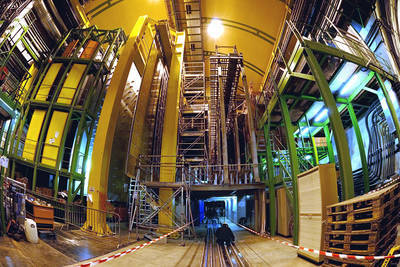
LHC pops out a new particle that could test the strong force
"There’s a new particle in town, and it’s a double-charmingly heavy beast. Researchers working on the LHCb experiment at CERN’s Large Hadron Collider have announced the discovery of the esoterically named Xicc++ particle. The find could help us probe our understanding of one of the four fundamental forces that govern the universe. The Xicc++ is a baryon, the family of particles that make up most ordinary matter and includes the likes of protons and neutrons. All baryons are made up of three quarks, a type of fundamental particle that comes in six different flavours. Theory suggests you can mix up these six in a variety of combinations to produce a whole host of baryons, but many of these combinations have yet to be observed in the real world." [...]
Outras Notícias
- Aquila's successful second flight: Another step forward in bringing the world closer together
- Elon Musk's boring machine completes the first section of an LA tunnel
- ArianeGroup signs a first contract with ESA to develop the future Prometheus engine
- SpaceX’s first re-flown Dragon capsule successfully returns to Earth
- NEC accelerates machine learning for vector computers
- New Mexico firm uses motion of the ocean to bring fresh water to coastal communities
- This website turns Wikipedia into a beautiful pixel art text adventure
- Researchers use Kinect to scan T. rex skull
Ciência e Tecnologia

Building with robots and 3D printers
"At the Empa and Eawag NEST building in Dübendorf, eight ETH Zurich professors are collaborating with business partners to build the three-storey DFAB HOUSE. It is the first house in the world to be designed, planned and built using predominantly digital processes. Robots that build walls, and 3D printers that print entire formworks for ceiling slabs – digital fabrication in architecture has developed rapidly in recent years. As part of the National Centre of Competence in Research (NCCR) Digital Fab-rication, architects, robotics specialists, materials scientists, structural engineers and sustainability experts from ETH Zurich have teamed up with business partners to bring several new digital building technologies from the laboratory into practice. Construction is taking place at NEST, the modular research and innovation building that Empa and Ea-wag built on their campus in Dübendorf to test new building and energy technologies under real-life conditions. NEST offers a central support structure with three open platforms, where individual construction projects – known as innova-tion units – can be installed. Construction recently began on the DFAB HOUSE." [...]

Tiny “motors” are driven by light
"Science fiction is full of fanciful devices that allow light to interact forcefully with matter, from light sabers to photon-drive rockets. In recent years, science has begun to catch up; some results hint at interesting real-world interactions between light and matter at atomic scales, and researchers have produced devices such as optical tractor beams, tweezers, and vortex beams. Now, a team at MIT and elsewhere has pushed through another boundary in the quest for such exotic contraptions, by creating in simulations the first system in which particles — ranging from roughly molecule- to bacteria-sized — can be manipulated by a beam of ordinary light rather than the expensive specialized light sources required by other systems. The findings are reported today in the journal Science Advances, by MIT postdocs Ognjen Ilic PhD ’15, Ido Kaminer, and Bo Zhen; professor of physics Marin Soljačić; and two others. Most research that attempts to manipulate matter with light, whether by pushing away individual atoms or small particles, attracting them, or spinning them around, involves the use of sophisticated laser beams or other specialized equipment that severely limits the kinds of uses of such systems can be applied to. “Our approach is to look at whether we can get all these interesting mechanical effects, but with very simple light,” Ilic says. The team decided to work on engineering the particles themselves, rather than the light beams, to get them to respond to ordinary light in particular ways. As their initial test, the researchers created simulated asymmetrical particles, called Janus (two-faced) particles, just a micrometer in diameter — one-hundredth the width of a human hair. These tiny spheres were composed of a silica core coated on side with a thin layer of gold. When exposed to a beam of light, the two-sided configuration of these particles causes an interaction that shifts their axes of symmetry relative to the orientation of the beam, the researchers found. At the same time, this interaction creates forces that set the particles spinning uniformly. Multiple particles can all be affected at once by the same beam. And the rate of spin can be changed by just changing the color of the light. The same kind of system, the researchers, say, could be applied to producing different kinds of manipulations, such as moving the positions of the particles. Ultimately, this new principle might be applied to moving particles around inside a body, using light to control their position and activity, for new medical treatments. It might also find uses in optically based nanomachinery. About the growing number of approaches to controlling interactions between light and material objects, Kaminer says, “I think about this as a new tool in the arsenal, and a very significant one.”" [...]
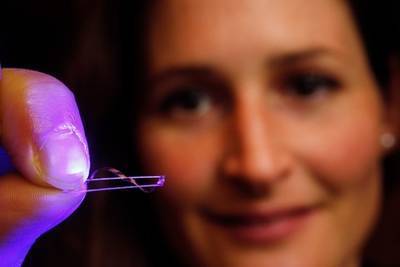
World first: new polymer goes for a walk when illuminated
"Scientists at Eindhoven University of Technology and Kent State University have developed a new material that can undulate and therefore propel itself forward under the influence of light. To this end, they clamp a strip of this polymer material in a rectangular frame. When illuminated it goes for a walk all on its own. This small device, the size of a paperclip, is the world’s first machine to convert light directly into walking, simply using one fixed light source. The researchers publish their findings on 29 June in the scientific journal Nature. The maximum speed is equivalent to that of a caterpillar, about half a centimeter per second. The researchers think it can be used to transport small items in hard-to-reach places or to keep the surface of solar cells clean. They placed grains of sand on the strip and these were removed by the undulating movement. The mechanism is so powerful that the strip can even transport an object that is much bigger and heavier than the device itself, uphill." [...]
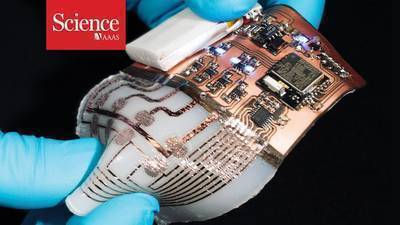
New ‘superglue’ could seal the deal for stretchable batteries, soft robots
"Superglue is great for fixing busted bookshelves, suitcase wheels, and—of course—shoes. But what if you want to fuse something a little more jiggly, like the gel cushions used to pad crumbling spinal discs? You’d be out of luck, until now. That’s because scientists have created a new kind of glue that can bond hard and soft substances to hydrogels, Jello-like materials used in everything from medical devices to soft robots. Previously, researchers in these fields used an ultraviolet light treatment, but it could take up to an hour or more to attach the surfaces together. Now, a team of experimental physicists has invented a new adhesive, made of superglue’s main ingredient—cyanoacrylate—plus an organic compound that diffuses into the parts being fused, leading to a tough bond without brittle residue left behind. This nonsolvent delays the hardening of the glue just long enough to let it seep into each layer being pressed together, forming a bond within seconds. The hydrogel bond can hold up to 1 kilogram and stretch up to 2000%, the researchers report this week in Science Advances. That’s good news for spine docs and robotics buffs alike—not only can the new adhesive help build devices like this octobot, but it can also be used to deliver drugs through soft, permeable patches that adhere to the skin. It can also help researchers designing stretchable batteries and electronic skin, hydrogel-based electronic patches packed with sensors for taking vital signs and communicating with outside devices. The only downside? It won’t be on the market for another 3 to 5 years." [...]
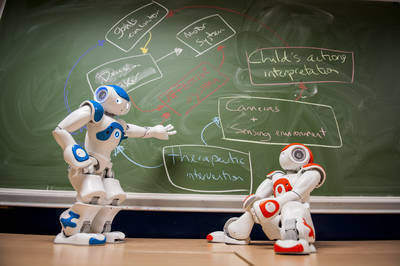
Robots to help children with autism
"New research involving the University of Portsmouth is aiming to develop robots to help children with autism in ways humans can’t. The Development of Robot-Enhanced therapy for children with AutisM spectrum disorders (DREAM) project will design robots that can operate autonomously and help the therapist to improve the child’s social interaction skills, such as turn-taking, imitation and joint attention. Robot-assisted therapies (RAT) have shown promise as potential assessment and therapeutic tools as research has shown that children with an autism spectrum disorder (ASD) engage more readily with robots rather than humans, because robots are simple and predictable. However, current social robots are simply remote-controlled by the therapists and like standard therapies, still require a lot of time, energy and human resources. The DREAM Project aims to develop an autonomous robot that minimises the therapist’s intervention so they can focus more on the child and improve the outcome of the therapy. The DREAM robot will also function as a diagnostic tool by collecting clinical data during therapy. The main task of the University of Portsmouth research group is to capture and analyse sensory data from the children – motion gestures, gaze, facial expressions, sound and voice – and make the robot understand what the child is doing so then they can have a better interaction. The team has substantial experience in multi-sensory data fusion, especially sensing and analytics for multi-camera systems. They have developed a multi-camera smart environment, consisting of a NAO robot, Microsoft Kinect® cameras and high resolution cameras that track and measure the child’s motions and facial expressions and interactions with the robot." [...]

Adaptive cyber security decision support to prevent cyber attacks
"Recognising the complexity of cyber attacks and the multi-stakeholder nature of tackling cyber security are the key components of a new data-driven cyber security system being developed by experts led by the University of Nottingham. The aim is to support organisations of all sizes in maintaining adequate levels of cyber security through a semi-automatic, regulary updated, organisation-tailored security assessment of their digital infrastructures. The £1 million project, funded by the Engineering and Physical Sciences Research Council (EPSRC) and the National Cyber Security Centre (formerly CESG), will establish the foundations for a digital ‘Online CYber Security System’ decision support service (OCYSS) which is designed to rapidly bring together information on system vulnerabilities and alert organisations which may be affected. The interdisciplinary project brings together academics in different areas of cyber security, information integration and decision making from the University of Nottingham, UK and Carnegie Mellon University, USA. They will be working closely with the UK's National Cyber Security Centre. Dr Christian Wagner, from the School of Computer Science at the University of Nottingham, who is currently also a visiting professor at Michigan Technological University, USA, is the lead academic. He said: “While the UK has access to some of the world’s leading experts in cyber security, the scale and variety of systems in UK organisations, both public and private, make it extremely challenging to flag potential system threats in a timely fashion. This international collaborative project targets a novel approach to semi-automatically identify system vulnerabilities, thus greatly increasing the efficiency and capacity to respond to emerging threats.” Also involved as co-investigators are Prof. Garibaldi, who has previously worked with the team at CESG on modelling expert decision making, and Prof. McAuley, who is Director of the Horizon Digital Economy Hub and has specific expertise in security and privacy research." [...]
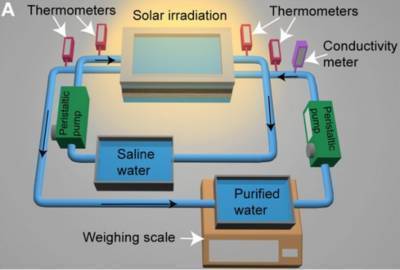
Clean Drinking Water From Solar Power
"Researchers from Yale and Rice University have developed a system that uses solar energy and nanoparticles to make saltwater drinkable. The system could potentially be used off-grid in remote areas or in domestic settings. The system, known as nanophotonics-enabled solar membrane distillation (NESMD), incorporates a porous membrane with carbon black nanoparticles. The nanoparticles use sunlight energy to heat water on one side of the membrane, which filters out salt and other non-volatile contaminants while allowing water vapor to pass through it. The results of the research are published this week in Proceedings of the National Academy of Sciences. The technology comes from the Center for Nanotechnology-Enabled Water Treatment (NEWT), a multi-institutional engineering research center. Based at Rice, it includes Yale and several other partners from industry, government and other universities. Funded with an $18.5 million grant from the National Science Foundation (NSF), NEWT was founded in 2015 to provide clean water to millions of people and make U.S. energy production more sustainable and cost-effective. In the most widely used desalination process, saline water passes through a membrane and emerges, desalinated, on the other side. Known as reverse osmosis, it has a very high energy-efficiency, but is ineffective on water with very high salinity. Many other desalination systems involve thermal processes in which water is evaporated using heat and then condensed. While effective, the method is energy-inefficient due to the amount of heat required. Thermal processes are often situated nearby power or chemical plants that provide steam as the heat source. There’s also membrane distillation, which uses both heat and membranes. It’s able to desalinate high-salinity water using low-grade or waste heat. However, it still requires an external heat source, which means that it needs to be connected to some form of energy infrastructure. With the NESMD system, however, the heat source is in the membrane itself. The nanoparticles, embedded on one side of the membrane use sunlight to heat the water and drive the desalination process. " [...]

Brookhaven Scientists Study Role of 'Electrolyte Gating' in Functional Oxide Materials
"Physicists at the U.S. Department of Energy’s Brookhaven National Laboratory have broken new ground in the study of functional oxide materials. The researchers discovered a previously unknown mechanism involved in “electrolyte gating,” a method for increasing electrical conductivity in materials and potentially inducing superconductivity. Their work was published on Monday, July 3 in Quantum Materials, a Nature partner journal. Superconductivity is the ability of a material to conduct electricity with zero loss or resistance. This effect is 100 percent efficient but has only been achieved at extremely cold temperatures, making it impractical for most large-scale applications. In Brookhaven’s Oxide Molecular Beam Epitaxy Group, led by Ivan Bozovic, researchers have been investigating oxides – chemical compounds with oxygen atoms – as potential high-temperature superconductors. Seeking to induce superconductivity in tungsten oxide, the researchers used a method called electrolyte gating. In this technique, electrically charged compounds draw ions with opposite charges away from each other, creating large electric fields and increasing a material’s electrical conductivity. Similar effects have traditionally been produced using a technique called chemical doping, which requires scientists to add new atoms to materials. Though productive, chemical doping is inefficient for finding new materials with interesting and useful properties because the conductivity of “doped” materials is fixed and cannot be easily changed if researchers want to test a material under different conditions. On the other hand, “Electrolyte gating allows you to tune materials,” said Tony Bollinger, a physicist at Brookhaven and one of the paper’s authors. “You can have one sample that you grow and then can continuously change—or tune—as you test it. It saves you from having to go back and synthesize new materials.” Until now, the underlying mechanisms of electrolyte gating were not fully understood. There were two competing theories, one focused on an electrostatic effect, another focused on an oxygen-related (electrochemical) effect. The team at Brookhaven, however, discovered an entirely new mechanism at play, where hydrogen plays a key role. By using a new method for patterning materials, the researchers were able to monitor the electrical resistance in sections near the site of electrolyte gating, not just in the immediate area. In this area, they observed a drop in resistance and a migration of positive charge. Based on the distance the charge moved, they were able to determine hydrogen atoms were moving through tungsten oxide." [...]

Keeping the heat out
"Most electronic devices currently contain silicon-based chips. Other semiconducting materials show potential, but need further research to become commercially viable. Researchers at KAUST have thoroughly analyzed one such material—metal-nitride nanowires—bringing them a step closer to being useful. When metal-nitride semiconductors are arranged into nano-sized wires they become extra sensitive to light, opening possibilities for optical electronics. One notable challenge however is that although metal-nitride nanowires perform well at low temperatures, thermal effects can greatly affect their performance at room temperature. To address this problem, Nasir Alfaraj with his Ph.D. supervisor Xiaohang Li and coworkers at KAUST have produced the most detailed study yet of these thermal effects. The researchers prepared gallium-nitride (GaN)-based nanowires in a p-i-n structure—a sandwich with layers of so-called p-type and n-type versions of the semiconductor surrounding an unaltered layer. N-type semiconductors are doped with materials that provide extra electrons, while p-types are doped with materials with fewer electrons, leaving “holes” in the crystal structure. Both electrons and holes act as charge carriers, giving semiconductor devices their useful electronic properties. “GaN-based p-i-n nanowires are suitable for fabricating signal attenuators, high-frequency digital switches and high-performance photodetectors,” said Alfaraj. “Yet, their performance is negatively affected when electrons and holes recombine, especially close to room temperature.” More specifically, when an electric field acts across a nanowire, the balance of electrons and holes can be affected, pumping heat away from the device in the form of thermal radiation. The devices effectively act as mini refrigerators, and their performance declines as they cool. To quantify this effect, Alfaraj and co-workers directed a titanium-sapphire laser onto their nanowires and measured the photoluminescent emissions that came out of the sample. They were then able to calculate the “photoinduced entropy” of the system: a thermodynamic quantity that represents the unavailability of a system's energy for conversion into work due to luminescence refrigeration. At system temperatures above 250 K, the electron-hole nonradiative recombination processes become dominant–electrons fall into holes, causing a rise in photoinduced entropy and reducing the device performance. “We plan to investigate photoinduced entropy in other materials, such as aluminum-gallium-nitride and zinc-oxide nanowires,” said Alfaraj. “We will also compare different nanowire diameters and investigate other structures, such as thin films.” These studies will assist engineers in making metal-nitride nanowire devices that are thermally stable and suitable for everyday use." [...]
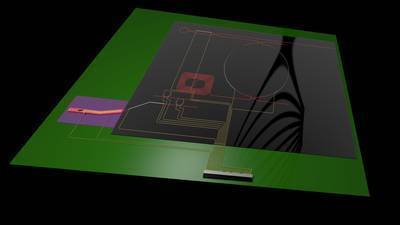
University of Twente develops record laser on chip smallest narrowband laser brings numerous photonic applications closer
"Working in collaboration with the Lionix company, researchers from the University of Twente’s MESA+ research institute have developed the world’s most narrowband diode laser on a chip. This laser represents a breakthrough in the fast-growing field of photonics, and will bring applications like 5G internet and accurate GPS closer. Research leader Professor Klaus Boller presented the research results during a prestigious scientific conference in Munich. We are slowly reaching the bounds of what is possible with electronics. That is why scientists and the private sector are committed to photonics – a key technology that makes numerous other innovations possible. This involves the deployment of photons (light particles) for transporting and processing data. For photonic chips to function as efficiently as possible, one has to be able to properly control the light signals. This means that all the light particles being transmitted must have, as closely as possible, the same frequency - that is, the same colour. The University of Twente researchers have managed to develop a minuscule laser on a chip with a maximum bandwidth (the maximum uncertainty of frequency) of just 290 Hertz. By some distance, this is the most accurate laser on a chip that has ever been created. Boller: “Our signal is more than ten times more coherent – or clean – than any other laser on a chip.” The newly-developed laser is tunable, which means that users can choose the colour of the laser themselves, within a broad range. The device is a hybrid laser, which means that it essentially consists of two different photonic chips, optically connected to each other." [...]

Engineers design “tree-on-a-chip”
"Trees and other plants, from towering redwoods to diminutive daisies, are nature’s hydraulic pumps. They are constantly pulling water up from their roots to the topmost leaves, and pumping sugars produced by their leaves back down to the roots. This constant stream of nutrients is shuttled through a system of tissues called xylem and phloem, which are packed together in woody, parallel conduits. Now engineers at MIT and their collaborators have designed a microfluidic device they call a “tree-on-a-chip,” which mimics the pumping mechanism of trees and plants. Like its natural counterparts, the chip operates passively, requiring no moving parts or external pumps. It is able to pump water and sugars through the chip at a steady flow rate for several days. The results are published this week in Nature Plants. Anette “Peko" Hosoi, professor and associate department head for operations in MIT’s Department of Mechanical Engineering, says the chip’s passive pumping may be leveraged as a simple hydraulic actuator for small robots. Engineers have found it difficult and expensive to make tiny, movable parts and pumps to power complex movements in small robots. The team’s new pumping mechanism may enable robots whose motions are propelled by inexpensive, sugar-powered pumps. “The goal of this work is cheap complexity, like one sees in nature,” Hosoi says. “It’s easy to add another leaf or xylem channel in a tree. In small robotics, everything is hard, from manufacturing, to integration, to actuation. If we could make the building blocks that enable cheap complexity, that would be super exciting. I think these [microfluidic pumps] are a step in that direction.” Hosoi’s co-authors on the paper are lead author Jean Comtet, a former graduate student in MIT’s Department of Mechanical Engineering; Kaare Jensen of the Technical University of Denmark; and Robert Turgeon and Abraham Stroock, both of Cornell University." [...]

Salto-1P Is the Most Amazing Jumping Robot We've Ever Seen
"Salto-1P uses a small motor and a system of linkages and gears to jump. Because it spends so little time in contact with the ground, the robot needs to do most of its control in the air. To do that, it uses a rotating inertial tail and two little thrusters to stabilize and reorient itself in between jumps. Last December, Duncan Haldane (whose research on incredibly agile bioinspired robots we’ve featured extensively in the past) ended up on the cover of the inaugural issue of Science Robotics with his jumping robot, Salto. Salto had impressive vertical jumping agility, and was able to jump from the ground onto a vertical surface, and then use that surface to change its direction with a second jump. It was very cool to watch, but the jumping was open-loop and planar, meaning that two jumps in a row was just about all that Salto could manage. Haldane mentioned to us in December that future work on Salto could include chaining together multiple jumps, and in a paper just accepted to the 2017 IEEE/RSJ International Conference on Intelligent Robots and Systems (IROS), he and co-author Justin Yim at UC Berkeley’s Biomimetic Millisystems Lab, led by Professor Ronald Fearing, show the improvements that they’ve made over the last six months. Thanks to some mechanical fine-tuning and the clever addition of a pair of thrusters, the new Salto-1P is jumping longer, faster, and higher than ever. Prepare to be amazed." [...]

New 3-D chip combines computing and data storage
"As embedded intelligence is finding its way into ever more areas of our lives, fields ranging from autonomous driving to personalized medicine are generating huge amounts of data. But just as the flood of data is reaching massive proportions, the ability of computer chips to process it into useful information is stalling. Now, researchers at Stanford University and MIT have built a new chip to overcome this hurdle. The results are published today in the journal Nature, by lead author Max Shulaker, an assistant professor of electrical engineering and computer science at MIT. Shulaker began the work as a PhD student alongside H.-S. Philip Wong and his advisor Subhasish Mitra, professors of electrical engineering and computer science at Stanford. The team also included professors Roger Howe and Krishna Saraswat, also from Stanford. Computers today comprise different chips cobbled together. There is a chip for computing and a separate chip for data storage, and the connections between the two are limited. As applications analyze increasingly massive volumes of data, the limited rate at which data can be moved between different chips is creating a critical communication “bottleneck.” And with limited real estate on the chip, there is not enough room to place them side-by-side, even as they have been miniaturized (a phenomenon known as Moore’s Law). To make matters worse, the underlying devices, transistors made from silicon, are no longer improving at the historic rate that they have for decades. The new prototype chip is a radical change from today’s chips. It uses multiple nanotechnologies, together with a new computer architecture, to reverse both of these trends. Instead of relying on silicon-based devices, the chip uses carbon nanotubes, which are sheets of 2-D graphene formed into nanocylinders, and resistive random-access memory (RRAM) cells, a type of nonvolatile memory that operates by changing the resistance of a solid dielectric material. The researchers integrated over 1 million RRAM cells and 2 million carbon nanotube field-effect transistors, making the most complex nanoelectronic system ever made with emerging nanotechnologies. The RRAM and carbon nanotubes are built vertically over one another, making a new, dense 3-D computer architecture with interleaving layers of logic and memory. By inserting ultradense wires between these layers, this 3-D architecture promises to address the communication bottleneck. However, such an architecture is not possible with existing silicon-based technology, according to the paper’s lead author, Max Shulaker, who is a core member of MIT’s Microsystems Technology Laboratories. “Circuits today are 2-D, since building conventional silicon transistors involves extremely high temperatures of over 1,000 degrees Celsius,” says Shulaker. “If you then build a second layer of silicon circuits on top, that high temperature will damage the bottom layer of circuits.” The key in this work is that carbon nanotube circuits and RRAM memory can be fabricated at much lower temperatures, below 200 C. “This means they can be built up in layers without harming the circuits beneath,” Shulaker says. This provides several simultaneous benefits for future computing systems. “The devices are better: Logic made from carbon nanotubes can be an order of magnitude more energy-efficient compared to today’s logic made from silicon, and similarly, RRAM can be denser, faster, and more energy-efficient compared to DRAM,” Wong says, referring to a conventional memory known as dynamic random-access memory." [...]

Hands off approach to looking into silicon chips
"The possibility of looking inside silicon chips to see their tiny working parts, without damaging the chips, is a step closer thanks to an international team led by scientists at UCL. The group at UCL, led by Dr Neil Curson (UCL London Centre for Nanotechnology), have shown they can generate pictures of tiny three-dimensional components, made from phosphorus atoms, that are completely invisible to all other imaging technologies. Remarkably, the pictures of these components were obtained despite the fact that the components were the size of only a few tens of atoms, were atomically thin and were buried under the surface of the chip. An accurate quantitative determination of the location of the buried components was obtained, along with certain electrical properties. This breakthrough is published in Science Advances. The components that were studied, including a three-dimensional criss-cross of metallic phosphorus stripes, were designed and manufactured by UCL PhD student Alex Kölker. He used a super-sharp metal needle to write patterns in a single layer of hydrogen atoms that lay on the surface of a silicon chip, creating a template of a desired shape. By causing a chemical reaction to happen between the surface of the chip and phosphine gas, phosphorus atoms were written into the surface, in the shape of the template. The phosphorus structures were then buried with more silicon to complete the device. A recently developed scanning microwave microscope was used to take pictures of the components, obtained with our collaborators at Johannes Kepler University, led by Georg Gramse, and by Keysight Technologies (Austria), Paul Scherrer Institut, ETH Zürich and EPF Lausanne (Switzerland). The microscope works by focussing microwaves (like those from a microwave oven), to the end of a metal tip which is pushed against the surface of the chip. The microwaves are fired into chip, subsequently bouncing back from the buried components, measured, and used to construct a picture." [...]
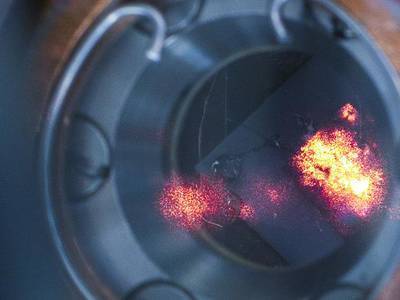
Spinning electrons open the door to future hybrid electronics
"A discovery of how to control spinning electrons paves the way for novel hybrid devices that could outperform existing semiconductor electronics. Researchers at LiU demonstrate how to combine a commonly used semiconductor with a topological insulator, a recently discovered state of matter with unique electrical properties. Just as the Earth spins around its own axis, so does an electron, in a clockwise or counter-clockwise direction. “Spintronics” is the name used to describe technologies that exploit both the spin and the charge of the electron. Current applications are limited, and the technology is mainly used in computer hard drives. Spintronics promises great advantages over conventional electronics, including lower power consumption and higher speed. In terms of electrical conduction, natural materials are classified into three categories: conductors, semiconductors and insulators. Researchers have recently discovered an exotic phase of matter known as “topological insulators”, which is an insulator inside, but a conductor on the surface. One of the most striking properties of topological insulators is that an electron must travel in a specific direction along the surface of the material, determined by its spin direction. This property is known as “spin-momentum locking”. “The surface of a topological insulator is like a well-organised divided highway for electrons, where electrons having one spin direction travel in one direction, while electrons with the opposite spin direction travel in the opposite direction. They can travel fast in their designated directions without colliding and without losing energy,” says Yuqing Huang, Ph D student at the Department of Physics, Chemistry and Biology (IFM) at Linköping University. These properties make topological insulators promising for spintronic applications. However, one key question is how to generate and manipulate the surface spin current in topological insulators." [...]
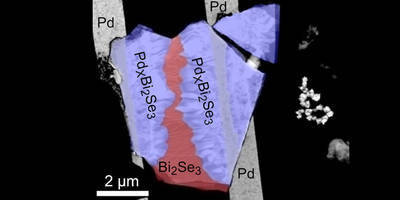
A New Method Could Enable More Stable and Scalable Quantum Computing, Penn Physicists Report
"Researchers from the University of Pennsylvania, in collaboration with Johns Hopkins University and Goucher College, have discovered a new topological material which may enable fault-tolerant quantum computing. It is a form of computing that taps into the power of atoms and subatomic phenomena to perform calculations significantly faster than current computers and could potentially lead to advances in drug development and other complex systems. The research, published in ACS Nano, was led by Jerome Mlack, a postdoctoral researcher in the Department of Physics & Astronomy in Penn’s School of Arts & Sciences, and his mentors Nina Marković, now an associate professor at Goucher, and Marija Drndić, Fay R. and Eugene L. Langberg Professor of Physics at Penn. Penn grad students Gopinath Danda and Sarah Friedensen, who received an NSF fellowship for this work, and Johns Hopkins Associate Research Professor Natalia Drichko and postdoc Atikur Rahman, now an assistant professor at the Indian Institute of Science Education and Research, Pune, also contributed to the study. The research began while Mlack was a Ph.D. candidate at Johns Hopkins. He and other researchers were working on growing and making devices out of topological insulators, a type of material that doesn’t conduct current through the bulk of the material but can carry current along its surface. As the researchers were working with these materials, one of their devices blew up, similar to what would happen with a short circuit." [...]

Peering into neural networks
"Neural networks, which learn to perform computational tasks by analyzing large sets of training data, are responsible for today’s best-performing artificial intelligence systems, from speech recognition systems, to automatic translators, to self-driving cars. But neural nets are black boxes. Once they’ve been trained, even their designers rarely have any idea what they’re doing — what data elements they’re processing and how. Two years ago, a team of computer-vision researchers from MIT’s Computer Science and Artificial Intelligence Laboratory (CSAIL) described a method for peering into the black box of a neural net trained to identify visual scenes. The method provided some interesting insights, but it required data to be sent to human reviewers recruited through Amazon’s Mechanical Turk crowdsourcing service. At this year’s Computer Vision and Pattern Recognition conference, CSAIL researchers will present a fully automated version of the same system. Where the previous paper reported the analysis of one type of neural network trained to perform one task, the new paper reports the analysis of four types of neural networks trained to perform more than 20 tasks, including recognizing scenes and objects, colorizing grey images, and solving puzzles. Some of the new networks are so large that analyzing any one of them would have been cost-prohibitive under the old method. The researchers also conducted several sets of experiments on their networks that not only shed light on the nature of several computer-vision and computational-photography algorithms, but could also provide some evidence about the organization of the human brain. Neural networks are so called because they loosely resemble the human nervous system, with large numbers of fairly simple but densely connected information-processing “nodes.” Like neurons, a neural net’s nodes receive information signals from their neighbors and then either “fire” — emitting their own signals — or don’t. And as with neurons, the strength of a node’s firing response can vary. In both the new paper and the earlier one, the MIT researchers doctored neural networks trained to perform computer vision tasks so that they disclosed the strength with which individual nodes fired in response to different input images. Then they selected the 10 input images that provoked the strongest response from each node. In the earlier paper, the researchers sent the images to workers recruited through Mechanical Turk, who were asked to identify what the images had in common. In the new paper, they use a computer system instead." [...]
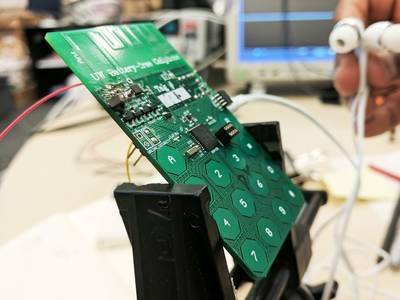
First battery-free cellphone makes calls by harvesting ambient power
"University of Washington researchers have invented a cellphone that requires no batteries — a major leap forward in moving beyond chargers, cords and dying phones. Instead, the phone harvests the few microwatts of power it requires from either ambient radio signals or light. The team also made Skype calls using its battery-free phone, demonstrating that the prototype made of commercial, off-the-shelf components can receive and transmit speech and communicate with a base station. The new technology is detailed in a paper published July 1 in the Proceedings of the Association for Computing Machinery on Interactive, Mobile, Wearable and Ubiquitous Technologies. “We’ve built what we believe is the first functioning cellphone that consumes almost zero power,” said co-author Shyam Gollakota, an associate professor in the Paul G. Allen School of Computer Science & Engineering at the UW. “To achieve the really, really low power consumption that you need to run a phone by harvesting energy from the environment, we had to fundamentally rethink how these devices are designed.”" [...]
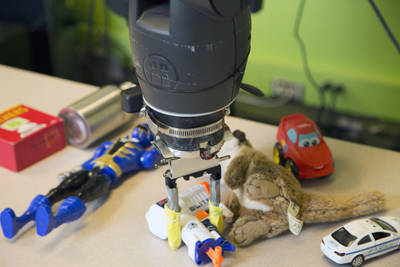
Teaching robots to learn about the world through touch
"Slowly, but surely, the Baxter robot is learning. It starts as a series of random grasps — the big, red robot pokes and prods clumsily at objects on the table in front of it. The process is pretty excruciating to us humans, with around 50,000 grasps unfolding over the course of a month of eight-hour days. The robot is learning through tactile feedback and trial and error — or, as the Carnegie Mellon computer science team behind the project puts it, it’s learning about the world around it like a baby. In a paper titled “The Curious Robot: Learning Visual Representations via Physical Interactions,” the team demonstrates how an artificial intelligence can be trained to learn about objects by repeatedly interacting with them. “For example,” the CMU students write, “babies push objects, poke them, put them in their mouth and throw them to learn representations. Towards this goal, we build one of the first systems on a Baxter platform that pushes, pokes, grasps and observes objects in a tabletop environment.”" [...]
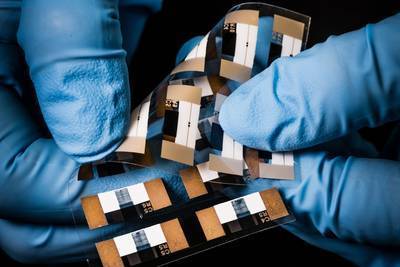
High-precision control of printed electronics
"Printed electronic transistor circuits and displays, in which the colour of individual pixels can be changed, are two of many applications of ground-breaking research at the Laboratory of Organic Electronics. New groundbreaking results on these topics have been published in the prestigious scientific journal Science Advances. The researchers in organic electronics have a favourite material to work with: the conducting polymer PEDOT:PSS, which conducts both electrons and ions. Displays and transistors manufactured from this polymer have many advantages, which include that they are simple and cheap to manufacture, and the material itself is non-hazardous. It has, however, been difficult to create devices that switch rapidly at a specific voltage, known as the “threshold voltage”. This gives that it has, so far, been difficult to control the current state of the transistors or the color state of the displays in a precise manner. “The lack of any threshold in the redox-switching characteristics of PEDOT:PSS hampers bistability and rectification, characteristics that would allow for passive matrix addressing in display or memory functionality” says Simone Fabiano, senior lecturer at the Laboratory of Organic Electronics, LOE, who is the principal author of the article in Science Advances, together with Negar Sani from the research institute RISE Acreo." [...]

Chances of hypersonic travel heat up with new materials discovery
"Researchers at The University of Manchester in collaboration with Central South University (CSU), China, have created a new kind of ceramic coating that could revolutionise hypersonic travel for air, space and defense purposes. Hypersonic travel means moving at Mach five or above, which is at least five times faster than the speed of sound. When moving at such velocity the heat generated by air and gas in the atmosphere is extremely hot and can have a serious impact on an aircraft or projectile’s structural integrity. That is because he temperatures hitting the aircraft can reach anywhere from 2,000 to 3,000 °C. The structural problems are primarily caused by processes called oxidation and ablation. This is the when extremely hot air and gas remove surface layers from the metallic materials of the aircraft or object travelling at such high speeds. To combat the problem materials called ultra-high temperature ceramics (UHTCs) are needed in aero-engines and hypersonic vehicles such as rockets, re-entry spacecraft and defence projectiles. But, at present, even conventional UHTCs can’t currently satisfy the associated ablation requirements of travelling at such extreme speeds and temperatures. However, the researchers at The University of Manchester’s and the Royce Institute, in collaboration with the Central South University of China, have designed and fabricated a new carbide coating that is vastly superior in resisting temperatures up to 3,000 °C, when compared to existing UHTCs. Professor Philip Withers, Regius Professor from The University of Manchester, says: “Future hypersonic aerospace vehicles offer the potential of a step jump in transit speeds. A hypersonic plane could fly from London to New York in just two hours and would revolutionise both commercial and commuter travel." [...]
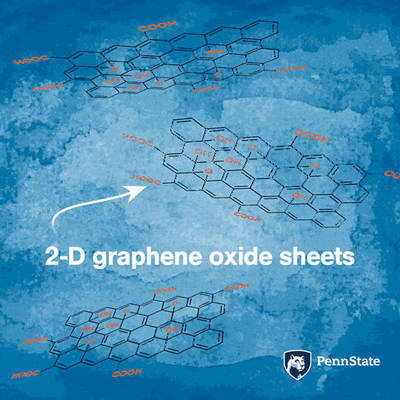
2D layered devices can self-assemble with precision
"Squid-inspired proteins can act as programmable assemblers of 2D materials, like graphene oxide, to form hybrid materials with minute spacing between layers suitable for high-efficiency devices including flexible electronics, energy storage systems and mechanical actuators, according to an interdisciplinary team of Penn State researchers. "2D layered materials can be made by vacuum (chemical vapor) deposition," said Melik C. Demirel, Pierce Development Professor and professor of engineering science and mechanics. "But the process is expensive and takes a long time. With chemical vapor deposition the problem also is we can't scale up." Materials like graphene oxide are composed of single layers of molecules connected in a plain. While the length and breadth of the sheet can be anything, the height is only that of one molecule. To make usable composites and devices, 2D materials must be stacked either in piles of identical sheets or combinations of sheets of different composition stacked to specification. Together with Mauricio Terrones, professor of physics, chemistry and materials science and engineering, and director of 2D Atomic Center, Penn State, Demirel and his team are currently looking at stacking sheets of identical materials using a solvent approach that self assembles. "Using the solvent approach the molecules are self-assembling, self-healing and flexible," said Demirel. "Currently we are stacking identical layers, but they don't have to be the same."" [...]
Modelos 3D
Com a disponibilidade de ferramentas que permitem dar azo a nossa imaginação na criação de peças 3D e espaços como o thingiverse para as publicar, esta rubrica apresenta alguns modelos selecionados que poderão ser úteis.
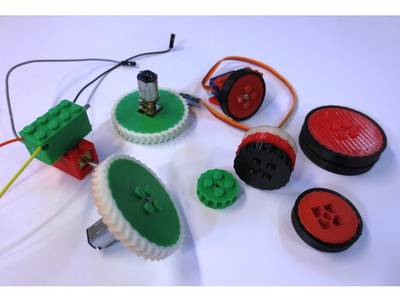
Parametric Lego Robot Wheels
"This is part of a set of customizable Lego compatible robotics components. This post is for parametric Lego compatible WHEELS. (Necessary Treads are a separate Thingy here: https://www.thingiverse.com/thing:2418636) (Thingy's are separate because each is its own customizer.) Files Included: An openscad file for generating any diameter of stackable Lego wheel with one of 5 different center configurations. A Lego slider in case you want to make the front of a robot slide freely without wheels. A special mount for gearmotors. (For servo motors check out https://www.thingiverse.com/thing:2417814) A calibration Lego brick for testing your printer. The wheels should be printed in a hard material like ABS. The treads must be at least semi flexible. The TPU linked below works but is a bit slick for mini-sumo and is tight for stretching. The TPE filament makes ideal high flex/stretch/friction treads." [...]
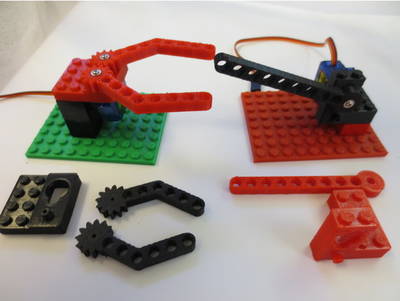
Parametric Servo Gripper Lego Brick Set
"This is part of a set of customizable Lego compatible robotics components. This post is for various Lego compatible 9g servo mounts. This fits either the popular SG90 or the FS90R (continuous) servos. Files Included: 6 differently oriented servo mounts. An openscad file for customizing the gripper/flag. (The flag is intended to be an accessory for a mini-sumo robot.) An openscad file for standard Lego bricks along with a printing calibration brick. (The compatible wheels shown are a separate Thingy.) I recommend printing brick parts in ABS, but the grippers in semi-flexible TPU. Printing Legos is tricky, see the print settings section for tips." [...]
Documentação
A documentação é parte essencial do processo de aprendizagem e a Internet além de artigos interessantes de explorar também tem alguma documentação em formato PDF interessante de ler. Todos os links aqui apresentados são para conteúdo disponibilizado livremente pelo editor do livro.

Electronica-Azi International no. 3 - June 2017
"Deadline Nearing to Enter Create the Future Design Contest. Win a Microchip BM64 Bluetooth Audio Evaluation Board. 3-phase Motor Drive as Intelligent Microsystem available at CODICO. XMOS announces XVF3000 voice processor for integrated far-field voice capture and VocalFusion(TM) Speaker development kit. The Long-Term Evolution of the Internet of Things. The Human Touch – How Superior Sensor Technology is Proving Instrumental in Making Robotic Movement More Graceful. Challenges of Designing and Handling Lithium-Ion Batteries. The efficiency of direct conversion in telecoms and datacoms. Make your vision become true with COMPEC. Lattice Semiconductor Introduces Ultra HD Wireless Solution to Deliver Blu-ray Quality Video. New MOST® Technology Intelligent Network Interface Controller Enables Daisy-Chain Communications in Automotive Applications. Latest PIC32 family increases performance while reducing power consumption. Flat and powerful. Microsemi Delivers AcuEdge Development Kit for Amazon Alexa Voice Service. Microchip extends eXtreme Low Power PIC32MM microcontroller family. SEGGER introduces J-Link EDU mini – a low cost J-Link focused on the education sector. Marvell Introduces Industry’s First Wi-Fi, Bluetooth 5 and 802.11p Combo Solutions for Vehicle-to-Everything (V2X) and In-Vehicle Infotainment (IVI). Microchip’s Wi-Fi® SDK with Apple HomeKit support now available. Microchip introduces the industry’s first MCU with integrated 2D GPU and DDR2 memory for groundbreaking graphics capabilities. Leti Announces Two New Tools for Improving Transportation Comfort, Safety and Efficiency. V2X leaders announce a collaboration that will deliver faster time to market with greater safety and security in V2X technology for automotive manufacturers. Wireless Gecko SoC Portfolio Supports Full Bluetooth 5 Connectivity and Expands Memory Options. TI unveils the world’s most precise single-chip millimeter wave sensor portfolio available today. Tronics MEMS Gyro Sensors Available for Immediate Shipment Globally through Digi-Key. Omron launches super-sensitive non-contact temperature sensor. TI enables the widest bandwidth and lowest phase noise for next-generation high-speed systems. Maxim’s Himalaya Step-Down DC-DC Converters Enable Rapid Compliance of Safety Standards for Industrial Applications. Maxim’s Dual IO-Link® Master Transceiver Ensures Robust Communications with 50% Lower Power for Industry 4.0 Applications. Ready-to-Use Panel PC in a modern design. TFT LCD display series for BeagleBone Black incorporates touch sensing over I²C. 150V Synchronous Step-Down DC/DC Controller Eliminates External Surge Protection Devices. TI introduces the industry’s smallest gate driver and power MOSFET solution for motor control. 300 W Medical Ac-Dc Power Supply Series Complies with 4th Edition EMC Standards. Powerbox reveals its high reliability power solution for subsea applications. XP Power launches low profile 225 Watt power supply in compact 3” × 5” U-channel format. Interflux Electronics introduces an Enhanced Low Melting Point Alloy" [...]
Projetos Maker
Diversos Projetos interessantes.
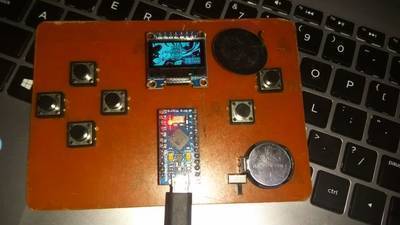
DIY Video Game Using Arduino (Arduboy Clone)
"There is an 8 bit, credit card sized gaming platform called Arduboy, that makes open source games easy to learn, share and play. You can enjoy 8-bit games made by others on this device, or you can make your own games. Since it is an open source project and uses arduino, I decided to make my own version of it. My goal was to design a PCB which is easy to make using toner transfer method. So I made the tracks and pads as large as possible. If you don't want to etch the PCB, you can make one on a breadboard or a Perfboard." [...]

POV Display With Wireless Power!
"So I was thinking of making a POV display gadget to decorate my home. As a decorative item, I really didn't like the fact that all POV display designs I found in the internet used batteries. What about after they run out of juice? Will I actually have to remove my fat ass out of my couch and stop it, take the batteries out or connect a connector to charge it? Most likely it will turn itself off and I'll never bother to turn it on again. Useless! Well, you get the point. It's a hassle and that's why most of these gadgets eventually end up lying around turned off in a garage/deposit. It's fun for the maker, but I just didn't want my creation to have such a sad end. So how can we change this? Brushes would work. Hmm... Too noisy, and might fail as well! I wanna go fancier. I wanna defy myself. Let's transfer the power wirelessly! I made a video (above) showing it working, because I know you want to see it working! Sorry for the camera flicker, this does not appear in reality. That's a feature of the "slow rotation speed" (24.3 Hz). Unfortunately I couldn't make it any faster! WARNING: I'm a hardcore hobbyist. All electronics are built from raw parts, no Arduino and no import pre-assembled packs. I also like to engineer as much as possible of the thing I'm making, so I'm sorry if this Instructable is not that easy to follow. I'll try my best, though!" [...]
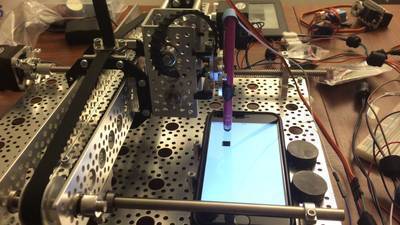
Screen Tapping Robot
"Do you need a robot who clicks the "like" button on all your friends' posts? This screen tapping robot clicks touch screen in the way you program it to!" [...]

Animated Snake Eyes Bonnet for Raspberry Pi
"The Snake Eyes Bonnet is a Raspberry Pi accessory for driving two 128x128 pixel OLED or TFT LCD displays, and also provides four analog inputs for sensors. It's perfect for making cosplay masks, props, spooky sculptures for halloween, animatronics, robots...anything where you want to add a pair of animated eyes! It’s a follow-on of sorts to another project: Electronic Animated Eyes Using Teensy 3.2. The Teensy 3.2 is a very capable microcontroller, and the code for that project squeezed every bit of space and performance from it. I had been experimenting with the Raspberry Pi as an alternative…while it’s still very experimental, why not make that work available to others?" [...]
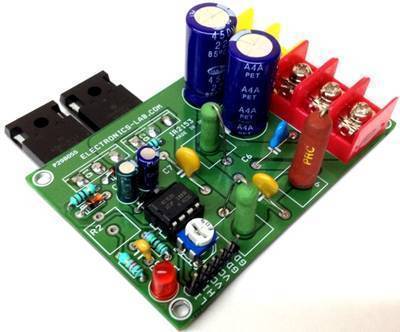
High Voltage-Current Half Bridge Driver Using IR2153 & IGBT
"IGBT based half bridge board has been designed for multiple applications, like induction heater driver, tesla coil driver, DC-DC converters, SMPS etc. High current and high voltage IGBTs are used to serve high power requirements. IGBT NGTB40N120FL2WG from ON semi and IR2153 from Infineon semiconductor are important parts of the circuit, IR2153 is a gate driver IC including inbuilt oscillator, 40A/1200V IGBT can handle large current. Gate driver circuit works with 15V DC and load supply 60V DC to 400V DC. The IR2153D(S) are an improved version of the Popular IR2155 and IR2151 gate driver ICs, and incorporate a high voltage half-bridge gate driver with a front end oscillator similar to the industry standard CMO 555 timer. The IR2153 provides more functionality and is easier to use than previous ICs. A shutdown feature has been designed into the CT pin, so that both gate driver outputs can be disabled using a low voltage control signal. In addition, the gate driver output pulse widths are the same once the rising under voltage lockout threshold on VCC has been reached, resulting in a more stable profile of frequency vs time at startup. Noise immunity has been improved significantly, both by lowering the peak di/dt of the gate drivers, and by increasing the under voltage lockout hysteresis to 1V. Finally, special attention has been played to maximizing the latch immunity of the device, and providing comprehensive ESD protection on all pins. Oscillation frequency adjustable by onboard Trimmer potentiometer, frequency spans approx. 12 KHz to 100 KHz, duty cycle 50%." [...]

Voice Controlled Bluetooth Car
"Everyone has used the remote controlled car.... but what about a voice controlled car??? Ever used it?If not then you will build it now. Just you need an arduino as the brains and a smartphone. So I have developed this project so that you can use the voice functionality and this can also be a reference for your future projects, So let's get started..." [...]

Smart Intercom
"This intercom uses facial recognition and RFID to control human access. The principle of operation: Person approaches to the intercom; Looks at the camera; The system compare his face with authorized people; If it finds it, then the door opens and a person can enter; There is also another way to pass; The person with the pass card place it to the RFID location and the door opens if it finds the code of this card in its database." [...]

Interfacing with a Toy - Process and Example
"There are many ways in which to interface a toy with an electronic system. The main considerations are: What types of control does the toy have? With what can these types of control be replaced? To what should the replacement of control be mapped? For example, take a simple button on a toy. This can be replaced with a relay, 40106-based oscillator, 4066 switch IC, 4051 multiplexer IC, digital switching mechanism, mercury tilt switch, magnetic switch, mechanical switch. This can be mapped from the physical world (tilting, magnetism), analog electronics (using the resistance of a pot of a 40106 oscillator to set the triggering speed), MIDI (note on, note off, CC, pitch bend etc), serial (on / off), ethernet etc. Let's examine an specific example of implementing this process. A simple toy phone was taken apart, and controlled via Teensy and USB-based MIDI." [...]
Actobotics Solar Tracker
"This is a simple robot that uses two photo resistors to track the incoming light from the sun and move to follow it. This robot could be very useful in many applications, including what its intended use as a solar panel alignment device to maximize the energy produced." [...]

Arduino Minimal Drum Kit
"This is minimal drum kit using arduino UNO. First of all, please check this instructables page. E-drum With Small 3D Printer and Thick Paper Since I started making this, I was captivated by piezo and electronic drums. I was fascinated by a very simple mechanism of electronic drums and the great invention called MIDI. In other words, I could not be satisfied just by making pads. This drum kit is roughly divided into two productions. 1.Pad made with a 3d printer and thick paper. 2.Trigger midi converter with arduino UNO . The signal sent from the pad of " 1 " is processed by arduino of " 2 " and converted into MIDI signal. And the MIDI signal is transmitted from arduino to iPhone, laptop, etc, and sound comes out. Let's make it!" [...]
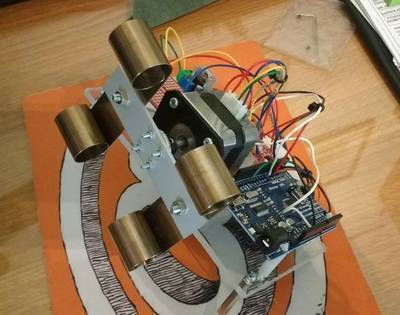
Dual Automatic Watch Winder
"I have been always wondering why the watch winder devices are so expensive. Such a tool is, however, necessary especially for guys like me who don't wear their watch everyday. So, I decided to make one of my own, using an Arduino controller. The basic idea is to use a stepper motor in order to rotate my watches. Moreover, by using the Arduino we can control the rotation frequency." [...]
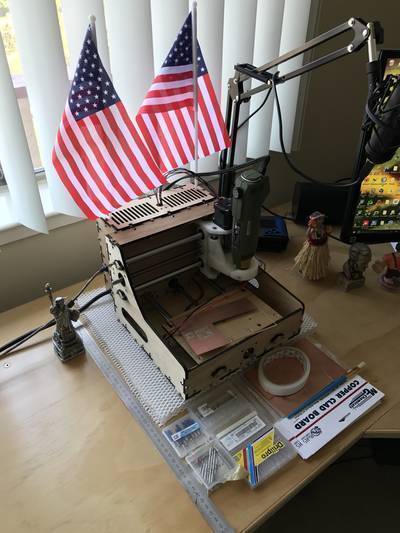
Sub $200 PCB Mill that doesn't suck!
"A PCB mill inspired by open source CNC 3D printers with a custom design to fit standard size copper clad boards (6" x 4" / 160mm x 100mm)" [...]

3D printed, internet controlled, self-balancing FPV robot
"Our newest design - it is fully 3D-printable self-balancing telepresence robot made as a visually better version of Husarion Development Kit. The robot can drive when balancing itself and can be steered via web browser. On a tablet you can see a person controlling the robot, and also that person can see you. Video streaming in two directions makes you feel like in remote location." [...]
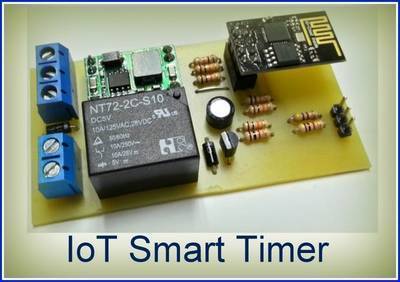
ESP8266-01 IoT Smart Timer for Home Automation
"With the new buzzwords being Internet Of Things (IoT) and Home Automation, I decided to look at the current items in and around my home that is controlled via some sort of device. The items that stood out, are the following: Swimming pool pump; Swimming pool water filler; Swimming pool and surrounding lights; TV/Entertainment system cabinet lights. The common item used to control these devices, are standard wall plug timers. Each device is fitted with it's own timer, and are all located in different locations. So why did I choose these items to begin with Internet of Things or Home Automation projects, you might ask? Well, living in South Africa, means power failures are a regular occurrence. With statistics of my home, I had 35 power failures in the past year, totaling 40 hours. This is normally not an issue, as all the currently installed timers are fitted with a back-up battery for time keeping during power failures. But there are some issues: These back-up batteries only last a year or two, then the timer has to be replaced. The timers are constructed such that the timer needs to be destroyed to gain access to the internal Ni-Cad battery. Each time the power fails, the timers with faulty batteries needs to be reprogrammed, and the time set. The physical location of the timer, when plugged into the wall socket, makes it almost impossible to read the lcd displays viewing the timer from the top. This means that the timer needs to be unplugged, or I have to lay down on the floor to set or adjust the timers after a power failure. Due to the above reasons, I decided to test the possibility to replace the timers with an IoT Smart Timer, connected to my local home network. The idea was to design a stand-alone timer, which can: Automatically adjust the current time using the internet (IoT); Operated without any user actions (Smart); Turn an output On/Off according to set times (Timer); Programmable and controllable via network (Home Automation)." [...]
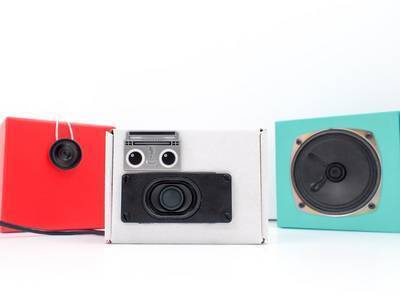
WiFi Music Alert Box
"You can turn the Internet of Things into the Internet of Tunes! With this easy-to-build project you can use online events to trigger your favorite songs. The Feather ESP8266 Huzzah is a WiFi connected board that can use the Music Maker FeatherWing with amp to play music at your command. Using the Adafruit IO service, a small bit of Arduino code and IFTTT (If This then That), events such as Twitter mentions, weather reports, YouTube uploads, news alerts, and more can trigger songs to play that you have stored on the included SD memory card." [...]
Building a Single Pixel Scanner
"A flat bed scanner typically uses three rows of CCD sensors (RGB) to capture images placed directly on top of the glass bed. When the CCD array scans from one end of the image to the other, the digitized color image is formed. So with a similar approach, we could use just one photosensitive device to capture the entire image one pixel at a time via raster scanning. Now that I have an HP 7044A X-Y recorder I could use it’s X/Y servo mechanism with a suitable sensor to build a single pixel scanner. The simplest sensor would be just a photodiode or a CdS photocell. For capturing grayscale images, either of these sensors could be used. To capture color images though, we would need a sensor that is capable of discerning the RGB components of each pixel. For that I used an inexpensive TCS34725 based color sensor module." [...]
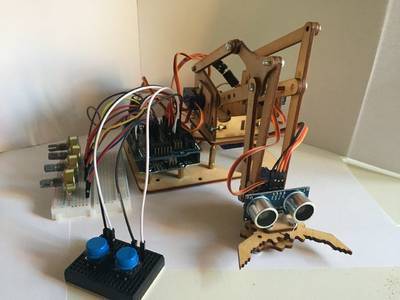
My MeArm Picking Up Things
"This Project is really special. I bought a MeArm (a popular, easy-to-find, inexpensive and easy-to-assembly Robotic Arm) . After putting everything together, I started with some typical stuff such as making it work with potentiometers in order to pick up some objects. It was nice at the beginning, but I got tired of it , so I decided to move on to something cooler. What I had in mind was to make my MeArm work on its own, detecting objects by itself, picking them up and eventually dropping them to a small bucket. Me just watching!!! In other words, I badly needed some way to tyde up my table once and for all. I started by google-researching similar projects but didn´t find much, so I had to start hardly from scratch. At first glance it seemed a challenging thing to be done, and after getting down to work it turned out to be even harder than expected. The good point: I ended up learning a bunch of things about Arduino and robotics, and it was really fun. And of course, when you see the final result…well, it is worth the effort! If you are interested in doing one of your own, I can save you most of the problems that I had (and believe me, I found a lot of them) and I can provide you with some explanations, tips and my code. With all this stuff, it should be rather straightforward to get there, so get ready and get down to it!" [...]
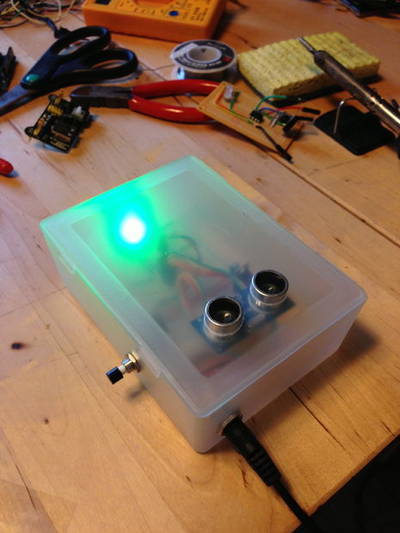
Ultrasonic Garage Parking Assistant With Arduino and an ATtiny85
"Hello fellow makers, I want to share with you a simple project that I have put together. I am new to prototyping/circuits and only took two semester of Java courses, so when I went looking for simple projects to build my skills, I was disappointed at how complex some of the code I saw was. While there are many other projects out there, with almost exactly the same in functionality, they were just too complex for the simplicity of the project. I believe I have put together a version that is much simpler and one that anyone can follow. In doing so, there may be some sacrifices in robustness(delay haters) but It works great so who really cares. Let's talk about the exact functionality. We are sensing distance all the time and have an rgb LED to indicate whether to keep coming, slow down, stop, or go back. A button is used to store the current distance as the desired parking distance. Even though the LED is super low power consumption, I am an environmentalist, so lets program in a power save mode to turn off the LED when there is no car in the garage and around 30 seconds after the car has parked in the right spot. Also, we cannot expect that the car will be parked at the exact, down to the inch, distance it was set at, so we will include a range of about 6 inches. You don't want to end up moving back and forth a dozen times before you get in right*. This is a big improvement over ones you can buy at Home Depot that only have 1, 2, and 3 foot distance settings and only 3 indicator stages. Plus, all the big box store ones look cheap and all have this ugly two part design where the LED or sensor are on a pull string. Not what I want in a classy garage. If you then want to make it smaller, cheaper and more permanent, plus, not have to leave your Arduino in it, flash the software over to an ATtiny85-20PU. We will go over all the required steps to use the Arduino as the ISP to load the software to the ATtiny." [...]
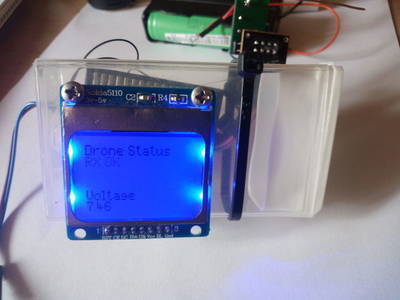
Arduino Wireless NRF24l01 Battery Voltage Monitor 5110 Screen and Low Battery Level Buzzer
"Arduino Nrf240l01 battery voltage monitor wireless with arduino" [...]
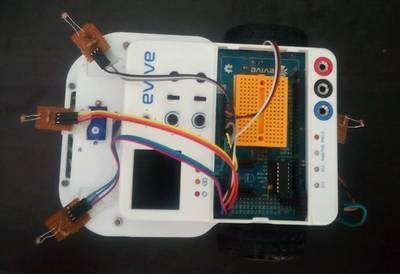
LDR light following robot
"A photoresistor is a light-controlled variable resistor.The resistance of a photoresistor decreases with increasing incident light intensity; in other words, it exhibits photoconductivity. A photoresistor can be applied in light-sensitive detector circuits, and light- and dark-activated switching circuits.This tutorial will use four photoresistors (light dependent resistors) and Evive to control the motion of a robot. Any common robot chassis can be used for the robot. The light sensors will be mounted on the left side, right side , front and back of the robot. When light of sufficient intensity falls on a sensor, the robot will respond with a left turn, right turn, forward or about turn (i.e. 180°) movement, corresponding to the location of the sensor that is activated." [...]
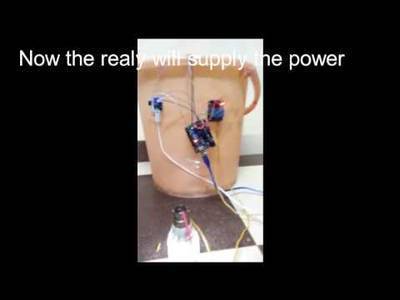
Water Level Monitoring Using BoltIoT
"Generally, in every house, there is a problem with a water tank. leaking of water if we forget that we put ON the motor, So I made a project which will give info about the water level in the tank and we can control the motor(ON and OFF). We will get the msg if the tank is empty and can make it on through our mobile app using Bolt device which has an integrated wifi chip(ESP8266) it helps to connect to the Internet. And we will control the motor using the Internet." [...]
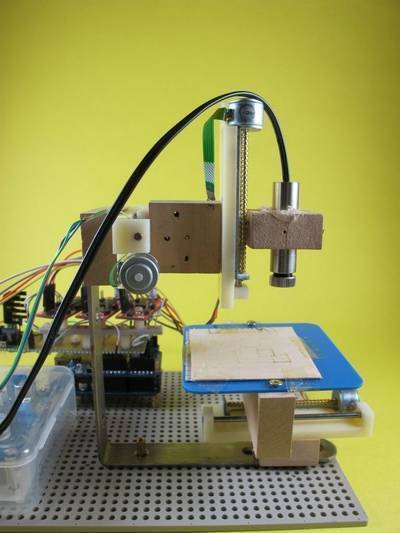
Arduino 3-axis Mini Lazer Paper-Cutter
"It is using Arduino Duemilanove + GRBL (0.8c) + 100mW blue/ violet lazer with external battery power supply (5V) Drawing program is inkscape + gcodetools, gcode sender is Unversai G Code Sender. I want to share with u but it is really difficult for me to explain it in english... I just want to share some experiences, or, may be u can ask me... Also, most of the technical things (especially about GRBL) u can find in the following articles." [...]
Control Adafruit Neopixels using Python and JQWidgets
"Low power wireless standards combined with low cost and ultra-miniature LEDs made smart lighting solutions a catalyst for the Internet of Things and home automation. In this tutorial, we’ll see how to control an Adafruit NeoPixel ring via mobile using Python and JQWidgets. In particular, we’ll see how to use Zerynth Studio to program the microcontroller-based board in Python and how to use Zerynth App to run the JQWidget-based GUI." [...]

Homemade Chess Robot
"In this Instructable, I show you how to build a chess robot! The chess robot was designed in 3 parts: the mechanical design, the electrical circuitry, and the Python/Arduino code. Each step can be completed individually and in any order you choose! The chess robot works by having a human player make a move, which the reed switch sensors detect and send the move to the python code. The python code chooses a computer move and sends it to Arduino to execute the move with the robotic arm." [...]

UNMOMENT - Ntp, Binary, Rgb CLOCK
"This is my hardest to read attempt of a clock. You need to know how a binary clock works and something about color-mixing lights. I don't think that anyone can read it, while the secons are ON, so there is a button to deactivate the seconds. Here is a short Video of it in action. It's hard to record colorful-light." [...]
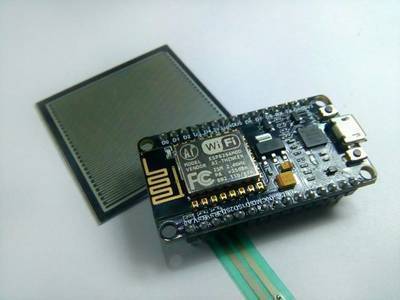
Interface Force Sensitive Resistor to Fade an LED Using NodeMCU
"I'm back with another cool Instructable. This Instructable is part of a series of Instructables with the NodeMCU, my previous Instructables shows you how to get started with the NodeMCU, and lots more. So make sure, you check that first before trying out this. In this instructable I'm going to show you how to use an FSR - Force Sensitive Resistor with NodeMCU to fade an LED. This sensor is a variable resistor just like a flex sensor. The resistance changes by applying pressure on it. So let's get begin...." [...]

Arduino101 / tinyTILE BLE: Match-Making Sunglasses
"Instead of using an app, what if you could send a signal to eye-contact someone you are interested in talking to, in a social setting, even from afar? I'm not proposing a different way to start a date. I'm exploring a new usage of Bluetooth in the field of human interactions. When I found out that Intel Curie modules can be assigned to act as central and peripheral BLE devices, I immediately wanted to make these glasses. (Learn more about CurieBLE from here.) Thanks to a tutorial on Adafruit, the reference framework of a 3D printed LCD glass is readily available. What I added onto the Adafruit tutorial are the BLE control (instead of a switch control) of two pieces of glasses at the same time, with one being the master and the other being the slave, and redesigned 3D printed frames." [...]
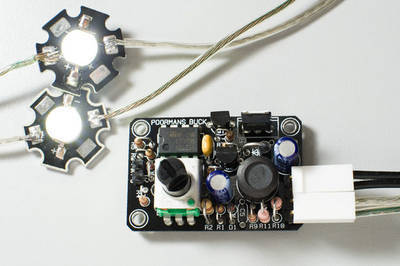
Simple Buck LED Driver With PWM Input
"High-power LEDs over 1W are now quite inexpensive. I'm sure many of you are incorporating LEDs as light sources in your projects. However I realize that the finding and configuring the power supply is still not as simple as it can be; commercially available LED drivers are convenient, but often overkill or not flexible. Even my own Universal LED Driver can be overkill at times. Some projects call for a bear minimum, simple driver. So I created the "Poorman's Buck" - simple switch-mode (buck) constant current LED driver that's built without a microcontroller or a specialized IC. All of the parts are easy to obtain, "off-the-shelf", though-hole parts. Even though this driver is minimalistic, I added a current adjust function that doubles as a dimmer, and an input to control the output with PWM. This makes the "Poorman's Buck" perfect building block for Arduino or other microcontroller based LED projects - you can control many high-power LEDs from a microcontroller simply by sending PWM signal. With Arduino you can simply use "AnalogWrite()" to control the brightness of high-power LEDs." [...]
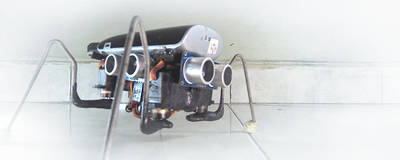
WALTER - The Arduino Insect Robot
"I really like the popular set-up of 2 servos arduino insects on youtube. When I looked at it, I always remember what BEAM robotic guys did long before that set-up became favorite. These people who are analog robot fanatics did better on the gait due to better angle between the two motors (microcore /bicore walker, etc). However, in my opinion, none of those mentioned before look more alive than VBug1.5 (also known as Walkman) created by the founder of beam robotic, Mark Tilden. It’s using 5 motors, therefore it has more maneuverability. Making a simple BEAM robot is not difficult, but building something as complicated as VBug1.5 could be distressing for an electronic novice like me. So, when I decided to make something like Tilden’s bugs, I had to settled with arduino platform, the easiest choice for non-engineers (or in my case, embarrassingly, an engineer wannabe). As a result, I made Walter, a 4 legged arduino robot with 5 servos. You may wonder, if I wanted to make a look-alive bug robot then why I didn’t go with 8 or 12 servos instead. Well, I was thinking something simplest I can do to get most maneuverability I can have. I’m talking about using a lot of glue instead of making frames." [...]
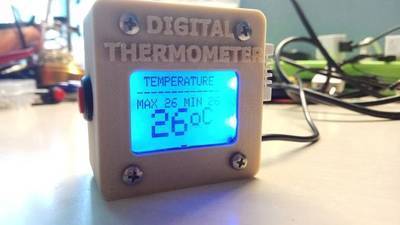
Arduino 3D Printed Digital Thermometer With DHT-22 Sensor
"In this guide I will show you how to make your own Arduino digital thermometer by using the DHT-22 sensor and Arduino Pro Mini board. It can be powered up from any USB power source and it can report the max and min values for temperature and humidity as it works. In this guide you will also find the .stl files of the 3d printed case/box. The DHT-22 (also named as AM2302) is a digital-output relative humidity and temperature sensor. It uses a capacitive humidity sensor and a thermistor to measure the surrounding air, and spits out a digital signal on the data pin. The DHT22 is a basic, low-cost digital temperature and humidity sensor. It uses a capacitive humidity sensor and a thermistor to measure the surrounding air, and spits out a digital signal on the data pin (no analog input pins needed)." [...]
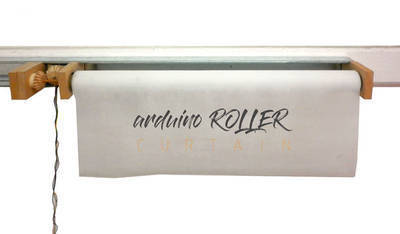
Roller Arduino Curtain
"The Arduino controlled Roller Curtain arises under the need of light and visual control that responds to the specific sun cycle in each room. It starts from observing the routine behavior we have to open and close our curtains; Arriving at the conclusion that it is much more comfortable to include them to the solar cyclic behavior. In the same way, it is observed that many times you have to deal with 2 types of curtain for the same window; One translucent and one opaque for day and night respectively. Due to the fact that in the first instance we try to respond to the incidence of specific light for each moment of the day, the Roller Curtain is proposed as a continuous mantle with translucent and opaque fabric that can be used for the required time and therefore not be present Simultaneously." [...]
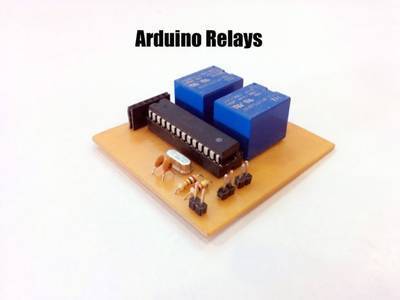
Arduino - Relays (Control AC Appliances)
"Arduino is an awesome micro-controller to get started with DIY electronics, but you can not control AC appliances with it directly. Relays help to do this the arduino drives a 5v relay, which in turn controls AC appliances. The only down side to a relay is that the frequency of switching is limited to low value. To over come this we could use triacs which I would demonstrate in a different instructable.In this instructable I'm going to show you how to get started with working with relays using the arduino UNO." [...]
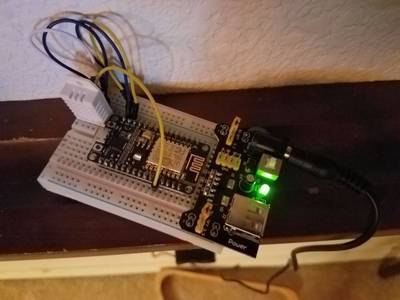
NodeMCU Webserver with Class-Based 60-Second Temp Average
"Averaging temperatures over 60 seconds smooths some of the sensor limitations, allowing for a smoother graphic." [...]

Pocketable 100W Power Supply-Smaller than your smartphone
"In this era everything is getting smaller but bench power supplies can get big and in no way are they portable so in this instructable I am going to show you how you can make a power supply that is probably smaller than you phone and you can carry it anywhere you go.You could either use the internal batteries or even connect it to an external power source (up to 100 that's what i tried) for more power. The on board voltmeter makes the job even easier and the 4 different fixed voltages make the operation a breeze. So lets get started." [...]
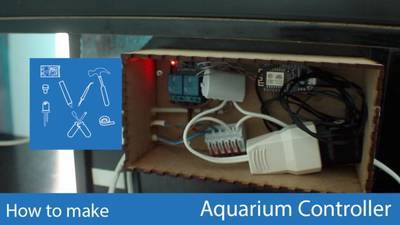
Aquarium Controller Using NodeMCU and MQTT
"For some time now I wanted to start automating parts of the house. Although several parties are already planned, I decided to start with the aquarium.Currently the aquarium has two analog timers to control lighting and water filtration. The problem is that whenever there is a light fault, the timers change the lighting and filtering times. To solve this problem, I decided to install a nodeMCU module, which receives water temperature data through a probe, controls lighting and filtering through a relay, and communicates with the Raspberry Pi that controls all IoT (Internet of Things) through MQTT (Message Queuing Telemetry Transport) messages" [...]
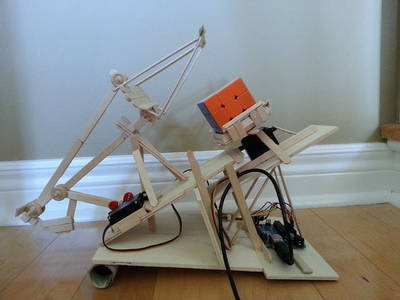
Rubik's Cube Solver
"So here's a project I've been working on for a while...This robot that can solve a Rubik's cube using Arduino.I learned how to solve a Rubiks cube last year, and I was also into Arduino, so eventually I ended up with an idea to make my own Rubik's cube solver.Like many people searching for "Rubik's Cube Solver" on Google, one of the first robots I found was the Tilted Twister design by Hans Andersson: I looked around at some other Rubik's cube solvers, but I liked that design because of it's (relative) simplicity, so I built a similar version of it with popsicle sticks, an Arduino and 2 servos.In the end, my robot takes about 20 minutes to enter the cube state and solve." [...]

Arduino Typewriter
"I modified a vintage type writer to function as a USB keyboard using an Arduino and 50 phototransistors. The typewriter is a German Olympia Monica that I bought at a local flea market. For this project I created a simple PCB that carries the phototransistors and several multiplexers and decoders. The PCB is connected to the Arduino through a ribbon cable. I used an Arduino Leonardo, which can function as a USB input device." [...]

Arduino - Web-Based Gauge
"This project shows how to monitor Arduino using a web-based gauge. By IoT_lover. We can monitor everything with this project, but I took the rotary angle sensor as an example. " [...]
That's all Folks!


